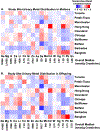Urinary metal profiles in mother-offspring pairs and their association with early dysglycemia in the International Hyperglycemia and Adverse Pregnancy Outcome Follow Up Study (HAPO-FUS)
- PMID: 36509832
- PMCID: PMC10261541
- DOI: 10.1038/s41370-022-00511-z
Urinary metal profiles in mother-offspring pairs and their association with early dysglycemia in the International Hyperglycemia and Adverse Pregnancy Outcome Follow Up Study (HAPO-FUS)
Abstract
Background: Variations in dietary intake and environmental exposure patterns of essential and non-essential trace metals influence many aspects of human health throughout the life span.
Objective: To examine the relationship between urine profiles of essential and non-essential metals in mother-offspring pairs and their association with early dysglycemia.
Methods: Herein, we report findings from an ancillary study to the international Hyperglycemia and Adverse Pregnancy Outcome Follow-Up Study (HAPO-FUS) that examined urinary essential and non-essential metal profiles from mothers and offspring ages 10-14 years (1012 mothers, 1013 offspring, 968 matched pairs) from 10 international sites.
Results: Our analysis demonstrated a diverse exposure pattern across participating sites. In multiple regression modelling, a positive association between markers of early dysglycemia and urinary zinc was found in both mothers and offspring after adjustment for common risk factors for diabetes. The analysis showed weaker, positive, and negative associations of the 2-h glucose value with urinary selenium and arsenic respectively. A positive association between 2-h glucose values and cadmium was found only in mothers in the fully adjusted model when participants with established diabetes were excluded. There was a high degree of concordance between mother and offspring urinary metal profiles. Mother-to-offspring urinary metal ratios were unique for each metal, providing insights into changes in their homeostasis across the lifespan.
Significance: Urinary levels of essential and non-essential metals are closely correlated between mothers and their offspring in an international cohort. Urinary levels of zinc, selenium, arsenic, and cadmium showed varying degrees of association with early dysglycemia in a comparatively healthy cohort with a low rate of preexisting diabetes.
Impact statement: Our data provides novel evidence for a strong correlation between mother and offspring urinary metal patterns with a unique mother-to-offspring ratio for each metal. The study also provides new evidence for a strong positive association between early dysglycemia and urinary zinc, both in mothers and offspring. Weaker positive associations with urinary selenium and cadmium and negative associations with arsenic were also found. The low rate of preexisting diabetes in this population provides the unique advantage of minimizing the confounding effect of preexisting, diabetes related renal changes that would alter the relationship between dysglycemia and renal metal excretion.
Keywords: Child exposure/ Health; Dietary exposure; Disease; Environmental monitoring; Health studies; Metals.
© 2022. The Author(s), under exclusive licence to Springer Nature America, Inc.
Conflict of interest statement
Conflict of Interest Statement:
All authors declare no conflict of interest.
Figures



References
-
- Klaassen CD, Watkins JB, Casarett LJ. Casarett & Doull's essentials of toxicology. McGraw-Hill Medical: New York, 2010.
-
- Nordberg G, Fowler BA, Nordberg M. Handbook on the Toxicology of Metals. 2014.
-
- Attar T A mini-review on importance and role of trace elements in the human organism. Chemical Review and Letters 2020; 3: 117–130.
-
- Bogden JD, Klevay LM. Clinical Nutrition of the Essential Trace Elements and Minerals. Springer, 2000.
-
- Nuttall JR, Supasai S, Kha J, Vaeth BM, Mackenzie GG, Adamo AM et al. Gestational marginal zinc deficiency impaired fetal neural progenitor cell proliferation by disrupting the ERK1/2 signaling pathway. The Journal of nutritional biochemistry 2015; 26: 1116–1123. - PubMed
Publication types
MeSH terms
Substances
Grants and funding
LinkOut - more resources
Full Text Sources
Medical

